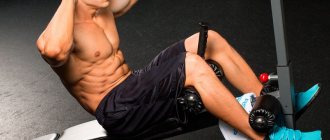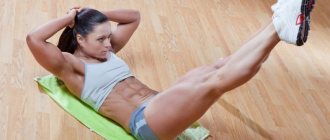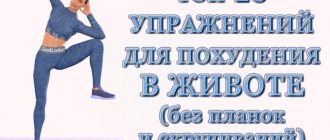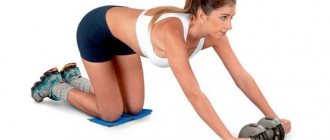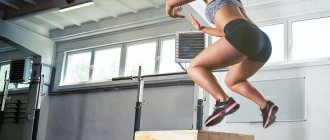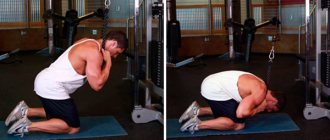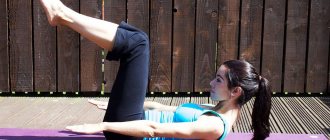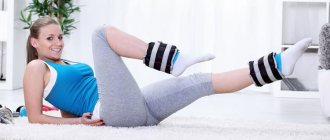Description and benefits of the exercise
The exercise is done while hanging on a horizontal bar or crossbar. Many gyms have a parallel bars simulator with a backrest. There are three options:
- raising bent knees is the easiest way;
- raising the lower limbs above parallel to the floor is a classic option;
- lifting your legs to the bar is a difficult way.
The peculiarity of raising legs while hanging is that in this way all the abdominal muscles are worked, even the especially complex ones - the lower ones. In addition, including the exercise in the training program will allow you to straighten your posture and usefully stretch the spinal column.
Such training is suitable for people whose bodies are already quite athletically prepared. By performing them, a person can not only achieve beautiful abs, but also develop muscle tone, and at the same time reduce the size of the chest and waist size. The risk of injury is minimal.
Preparatory exercises
Teaching the “horizon” element includes a number of preparatory exercises, each of which requires step-by-step development. Before performing static exercises, it is recommended to start with strength exercises that prepare the muscles. It is also important to prepare your shoulders to support your body weight with your muscles rather than your joints.
Below are several exercises that are performed in sequence as a preparatory workout:
- Exercises with a barbell or dumbbells. The sports equipment is taken with palms down and slowly raised with outstretched arms in front of you, the exercise is repeated several times. It is good to perform statics with a barbell or dumbbells; for this, the apparatus is raised to shoulder level and held on outstretched arms for as long as possible.
- Push ups. This exercise helps develop the muscles of the back and shoulders. During the execution of the element, it is necessary to move the body forward. If you cannot achieve this position the first time, you can gradually tilt your torso forward during each workout.
- Push-ups on hands with feet against the wall. During the exercise, the body weight is transferred to the arms, while the legs should not rest against the wall, but only slide along it. The readiness of the shoulder muscles for the “horizon” is determined when a person can perform three sets of 20 push-ups.
- Float. During the exercise, the emphasis is on the triceps. Take a position with emphasis on the palms and feet; at the initial stage, bending the arms is allowed. Resting your knees on your elbows, lift your bent legs off the floor, lifting your lower back. It is necessary to maintain balance for at least a few seconds, gradually increasing the interval.
- Exercise “closed horizon” (with legs lifted). You can include such a load in training only after the elements described above have been consolidated. Place your hands on the floor, legs straight, body straight. The weight is transferred to the arms, the legs are lifted off the floor and the body is kept suspended for as long as possible. When it becomes easy for an athlete to perform such a plank, he can make it more difficult by pressing his knees to his chest.
Muscles involved
When lifting your legs to the bar, seven muscle groups are used: two main and five additional.
Basic
When performing the exercise, the main, external and internal oblique abdominal muscles work. They come into action when the lower limbs are raised above an angle of 45°.
There are over 400 muscles in the human body that perform specific functions. Muscle tissue alone accounts for a load of approximately 20 kg, which is 40% of the total mass of the human body. The strongest muscle is the tongue, the fastest is the blinking muscle, the largest is the gluteal.
Additional
Bending the legs is carried out with the help of the hip flexors: pectineus, lumbar minor and major, adductor longus, and rectus femoris. The static load falls on the arms, back and shoulders.
What muscles are trained?
When lifting your legs in a hanging position, the muscles of the abdomen, legs and back are activated:
- the main ones that take the greatest load: oblique and rectus abdominis muscles;
- additional, those that work less hard: iliopsoas, rectus femoris, pectineus, sartorius;
- muscles that stabilize the load on the body:
- abdominal muscles;
- shoulder blades: rhomboids, serratus anterior, and lower trapezius;
- shoulder: rotator cuff, latissimus dorsi;
- carpal.
Number of approaches and correct technique
The choice of one of three techniques - simple, classical or complex - depends on the physical preparation of the trainee.
Step 1. In order to perform the exercise correctly, you need to reach the bar and grab it with your palms. Grip – shoulder width apart. The legs should either lightly touch the floor or hang freely. They need to be pulled back a little. This will be the starting position.
Step 2. While inhaling, you should twist your pelvis forward and raise your legs (bent or straight) to the point where they are above parallel to the floor, i.e. The angle between the hips and the body should be less than 90°. You will need to hold in this position for 3-5 seconds. Exhale.
Tips and tricks
Below we give some tips and recommendations on the technique of performing hanging lower limb lifts, which will help to avoid gross mistakes and wasted efforts for beginners and to perform the exercise efficiently for those whose sports training is at an average and higher level.
Basic mistakes of newbies
Beginners tend to make the following mistakes that should be avoided:
- strong swaying of the body and lifting of the lower limbs by inertia - when done this way, the exercise will bring absolutely no benefit;
- relaxation of the muscles of the shoulder girdle;
- helping with hands;
- improper breathing.
To avoid swinging, you need to learn to lower your legs smoothly and pause when they reach the lowest point.
About the features of the exercise and common mistakes:
Execution Features
- When performing the exercise, you can use straps to secure your hands on the bar and elbow clamps. They will help you focus only on your abdominal muscles.
- The hands are not used during execution; they are relaxed and are used only for gripping.
- For maximum load on the oblique abdominal muscles, it is necessary to twist the body left and right - this is done with bent knees, which turn in different directions, rising each time.
- When lifting your legs, you need to tuck your pelvis - this will allow you to maximally tense your abdominal muscles.
- Inertia is unacceptable when performing this exercise. The ankle should rise and fall at each segment of the amplitude in the same amount of time.
- The lowering of the lower limbs should not be carried out completely - they should stop at the level of 15-25°. This way the abdominal muscles will remain tense throughout the entire exercise.
- It is not recommended to attach additional weights to your shins. The legs are a normal load to achieve the desired result.
- The chest must be kept open.
- If you feel pain in the lower back, you need to spread your toes and knees, while leaving your heels closed to each other. This should be more comfortable.
- If you cannot stabilize your body, you can ask a partner or instructor to hold you from behind.
- You need to look straight ahead. The chin resting on the chest is undesirable.
- At the end point of lifting your legs and after fixing them for two seconds, you need to additionally tense your abs.
- For beginners, it will be easier to do lifts of the lower extremities in a vertical position on the Swedish wall or parallel bars with a vertical back.
- The smaller the angle between the body and the hips, the greater the load on the abs.
Raising your legs only parallel to the floor does not give any results to the abdominal muscles. It should be above an angle of 90°. - A reverse grip on the bar is not recommended.
- The main attention should be paid not to raising the lower limbs, but to lowering them.
Execution technique
As already mentioned, the exercise has three degrees of difficulty: simpler (lifting legs with bent knees), classic (legs straight or slightly bent) and more difficult (straight legs raised all the way to the bar).
Let's consider the universal technique of performing the movement, and each athlete determines which variation to choose, depending on his level of physical fitness.
- Starting position – hanging on a bar or horizontal bar with straight arms and legs. The height of the crossbar should be such that your feet either lightly touch the floor or (better) not touch it at all. When performing the exercise, the hands play the role of coupling with the crossbar, that is, they do not participate in the movement. Twist your tailbone slightly forward, feeling that your abs are tense.
- As you exhale, lift your legs and twist your pelvis forward. The angle between your torso and your hips should be less than 90 degrees, regardless of whether you raise your knees or straighten your legs. That is, the hips rise above parallel with the floor, and the pelvis twists forward. By the way, it will be extremely difficult to lift your legs completely straight if you have insufficient stretching of the back of your thighs. Therefore, as a rule, most athletes lift their legs not completely straight, but slightly bent. At the top point, hold for a couple of seconds.
- If possible, slowly lower yourself to the starting position. Perform the required number of repetitions.
The higher you raise your legs, and the straighter your legs are, the greater the load on your abs. Maximum tension of the abdominal muscles will require lifting the legs to the bar itself. In this case, all areas of the rectus abdominis muscles, and not just their lower region, receive significant load.
If you want to additionally load the oblique muscles, add side-to-side trunk crunches, that is, turn your knees to the right and left with each lift.
Aim for at least 15-20 reps in 3-4 sets. This will be difficult at first, so do as many repetitions as you can.
Contraindications
There are no special contraindications to including knee raises or straight leg raises while hanging. It is not suitable for people who:
- lower back problems;
- the ability to stabilize the body is poorly developed;
- the problem area is the shoulder joints;
- there were injuries.
In such cases, it is better to replace the exercise with crunches performed on an inclined bench or reverse crunches performed on the floor.
Warm-up
An approximate warm-up before performing the “horizon” exercise is as follows:
- Rotational movements knead the joints of the hands. Start the exercise with a small amplitude, gradually increasing it. One set of 10 rotations.
- Tilt the head left and right, back and forth 10 times.
- Tilt the body left and right 10 times. Circular movements of the body clockwise and counterclockwise 10 times.
- Bend down 10-20 times.
- Bend down and jump up 10-20 times.
- Boxing 30 times at the first stage, gradually increasing to 50 times.
- Delta stretching. With your left hand, take the right shoulder and press it towards the sternum, then repeat the exercise with the other shoulder.
- Pull-ups on a wall bars or horizontal bar 5-10 times.
- Push-ups on the floor from 5 to 20 times, 3 sets.
- Push-ups with legs against the wall from 5 to 20 times, 3 sets.
- Lifting dumbbells on straight arms from 10 to 30 times in 3 sets.
- Plank on straight arms 30-60 sec.
- Side plank 30-60 sec.
- Hitch.
Additional abdominal exercises
When planning hanging leg raises in an abdominal strengthening training program, it should be placed very first, as one of the most difficult. Behind it, place twists, lifts of the legs and body in various ways.
The most effective for the press are:
- hanging knee raises;
- press roller (roller).
Twisting on the floor with straight legs is least effective.
Any exercises designed to pump up the abs give the maximum and fastest effect if performed regularly, correctly, until you feel a burning sensation. Hanging leg raises are one of the most difficult abdominal exercises, but also the most effective. If carried out correctly, muscle strengthening can be felt within 2-3 weeks after the start of training.

